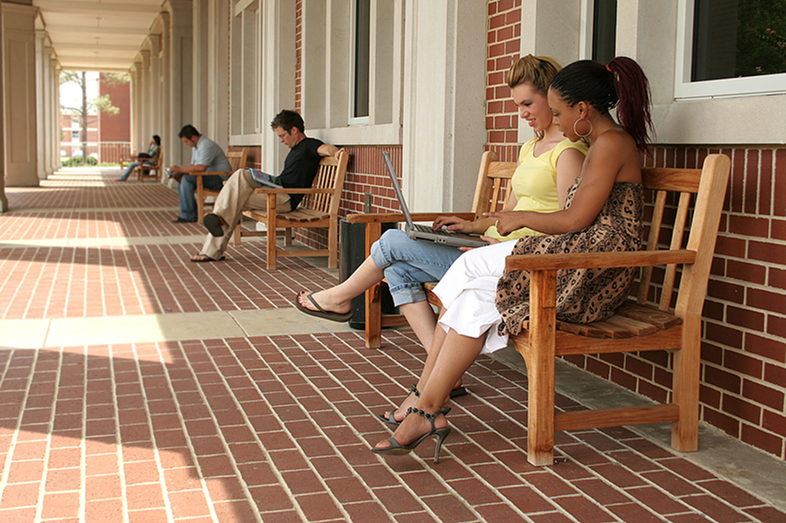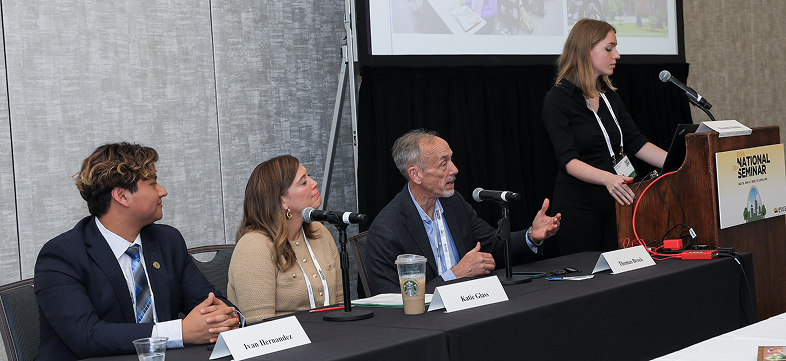
Unexplored Stories on Community Colleges
Here’s why reporters should be covering their local community colleges.
Photo credits: Ixepop/Bigstock; James Minichello for EWA

Here’s why reporters should be covering their local community colleges.
Photo credits: Ixepop/Bigstock; James Minichello for EWA
Higher education news overwhelmingly focuses on four-year universities, often treating that experience as the default. The result? Little media representation for community colleges, which enroll roughly 40% of college students in the U.S.
Though they tend to fly under the radar of many education reporters, community colleges are becoming “more innovative, more transparent and more outcomes-focused,” said Katie Glass, chief communications officer at Southwest Wisconsin Technical College.
Diving into these vastly under-covered institutions opens reporters up to a wealth of untapped stories. Here’s what to know.
Two-year colleges were first designed to help students transfer to a university, where they’d finish their four-year degree. But over the last few years, there’s been “more focus on the workforce function of community colleges and maybe a de-emphasis on a lot of the transfer functions,” said Iris Palmer, director for community colleges at New America, a left-leaning think tank.
While helping students prepare for university will always be a large part of the community college model, there’s also a growing push for college leaders to focus less on general “transfer” degrees and instead help students specialize in high-demand fields, complete workforce training and obtain short-term certificates.
Increasingly, people view community colleges as the link to meet the demands of the local workforce, Palmer said.
Many community colleges are also expanding the types of services they offer, and they’re trying to become more accessible to a larger number of students.
Nearly half of states now allow some community colleges to offer bachelor’s degrees, and a growing number of institutions are taking advantage of it. Lawmakers and college leaders say making it easier and more affordable for rural and low-income residents to get degrees is addressing workforce shortages.
While community colleges have historically been commuter schools, even that is changing. In 2023, nearly 3 in 10 community colleges offered on-campus housing, up from 22.8% in 2010, according to the American Association of Community Colleges.
More and more, community colleges are helping students navigate the barriers that traditionally keep them out of higher education, such as finances or child care needs. At Southwest Wisconsin Technical College, for example, staff help students create personalized budgets.
“This is not community college as it used to be,” Glass said. “This is what student-centered higher education looks like.”

Since returning to office, President Donald Trump has targeted higher education institutions and funding that flows to them. While news stories have highlighted universities in disarray, community colleges have largely been left out of the conversation — sometimes even struggling to understand how federal directives apply to their institutions amid the firehose of changes.
“What you’re seeing from the current administration is a view that higher education has lost its way a little bit — it’s become overly politicized. It is characterized by liberal viewpoints,” said Thomas Brock, director of Columbia University’s Community College Research Center. “Those criticisms are directed to four-year institutions and, in particular, more elite institutions — colleges and universities that have a more traditional liberal arts focus, where there’s been a lot of encouragement over the years for students to think about and explore issues related to race and income inequality and so on.”
Community colleges tend to be more focused on practical, hands-on programs that give students a skill to help them seek work. About half of students who enter community colleges are pursuing applied associate degrees, Brock said, such as certificates in culinary arts, nursing or informational technology.
“I don’t think anyone accuses the faculty or the students who are in those programs as being concerned about spending their time in class debating these larger political issues,” Brock said.
That helps community colleges enjoy rare bipartisan support, he said.
Some of the most high-profile moves by the Trump administration haven’t hurt community colleges the way they have universities. Community colleges generally don’t receive federal research funding, so they weren’t hit by National Institutes of Health cuts. In general, federal dollars make up a much smaller share of community college funding than that of universities; community colleges instead receive more local and state dollars. For example, Houston Community College in Houston, Texas received roughly $16 million in federal grants and contracts in 2023-24, or 3% of the school’s $585 million in revenue. This doesn’t include federal financial aid, which is funneled directly to students.
Though community colleges aren’t the direct target of the administration’s war on higher education, that doesn’t mean they’re immune to the effects.
“Even though they’re not being as politically publicly targeted as high-prestige research institutions, I think they’re going to get caught in the crosshairs,” said Palmer of New America.
Community colleges, too, have been impacted by frozen federal grants and the administration’s efforts to root out diversity, equity and inclusion on campus. Some institutions, spooked by Trump’s anti-DEI executive order that threatens to revoke federal funding, have stripped back DEI initiatives, despite generally serving more diverse student populations and relying much more heavily on local funding than federal dollars.
Community colleges experienced a serious taste of collateral financial damage in early July, when Trump froze $6.8 billion in education funds. This included $715 million for adult education programs — which community colleges are often the largest providers of. The funds were released in late July, but the debacle had institutions worried about potentially having to cut their services.
There are many myths about the community college experience, and journalists can play a role in dispelling them. Watch out for these stereotypes in your reporting.
The biggest myth that dogs community colleges is that the education is lower quality than that of a four-year university, said Amanda Fenwick, vice president of external relations for San Jacinto College in Pasadena, Texas.
Fenwick said people often think the “classes aren’t as hard; they’re not as rigorous; students don’t get the same kind of opportunities and college culture that you get at four years — and that couldn’t be any further from the truth.”
News coverage that focuses on the unique roles that community colleges play – rather than how they compare to universities – can help paint a more accurate picture of their offerings. For example, community colleges often work in close partnership with local businesses and industries. They tailor programs to the local workforce’s needs and draw local professionals to teach classes.
“To me, it’s more about what differentiates us. We’re close to home. We’re affordable. … That’s just what community colleges do,” Fenwick said. “It’s just as rigorous in the classroom, and sometimes more so, with all the workforce training that we do. Sometimes those standards – because our workforce partners expect that – are a little bit higher.”
There’s an impression that community colleges lack “student experience” – that students drive to campus for classes and leave promptly after – largely because the students don’t typically live in on-campus dorms like at universities, Fenwick said.
But don’t forget that most community colleges have clubs, sports teams, student governments, advocacy organizations and more. Plus, these are all great places to find sources.
As a matter of fact, 9% of community college students already have a bachelor’s degree.
There are many different paths that lead students to community college. Reporters should be careful not to feed into this stereotype by assuming all students are at a community college for the same reason.
Some are preparing to transfer to a four-year university. Some are obtaining training credentials that they can take straight to the workforce. Others are workers completing additional training to advance in their careers. Community colleges are also often the main providers of adult education programs, which help adults and immigrants complete high school, learn English and improve their literacy skills, among other programs.
Make time to ask students about their journey to college and what their future plans entail — you might be surprised.
“When you meet a student balancing two jobs, caring for their family, and earning a degree that leads to a living wage, the story of community college shifts from stereotype to strength,” Glass said.
Dual enrollment courses – which allow high school students to earn both high school and college credit simultaneously – are exploding in popularity. At some community colleges, high schoolers now comprise the majority of enrollment.
Reporters should pay attention to what their local schools are doing to expand dual enrollment, if enrollment access is equitable and how students are performing.
It’s no secret that fewer men are interested in college, a phenomenon dubbed the “male enrollment crisis.” Just 43% of all undergraduate students are men, according to the Education Data Initiative.
But there are “encouraging signs” that more young men have returned to community colleges in recent years, Brock said.
“We think a lot of that too is related to the hands-on, work-oriented programs that community colleges provide,” Brock said. “Just going to a community college campus and talking to the young men who are there about, ‘Who are they? What are their motivations? What do they look to get out of this experience?’ I think there could be a lot of interesting stories there.”
Don’t neglect community college students when exploring how Trump’s policies – such as travel bans and immigration crackdowns – affect undocumented, international and immigrant students. Their experiences will be different from a university student’s and worth highlighting.
Fenwick recommends reporters explore what “community colleges are doing to help those students stay enrolled — to make sure that they can complete school if they’ve started.”
Additionally, many don’t realize that community colleges enroll a lot of international students, Palmer said, which can generate significant revenue; those students pay steeper tuition costs. She recommends watching how community colleges are preparing for lower international student enrollment and reduced tuition revenues.
Explainers or listicles that highlight the costs and financial resources at different colleges can be useful to students.
“The differences that exist across different sectors of higher education are not always well understood by many Americans and kind of spotlighting that and saying, ‘Hey, there is this alternative,’” Brock said. “It is quite reasonable in almost every state, if you’re very low income, a Pell Grant will cover the entire cost of at least the tuition and fees that a community college charges.”
As community colleges tend to receive less in-depth news coverage, there’s likely ample opportunity for reporters to serve as the watchdog their local institution is missing.
Ask questions, such as: Did that flashy program end up paying off? Why hasn’t that college’s lackluster graduation rate budged in a decade? What are the main concerns students at the college have?
Your post will be on the website shortly.
We will get back to you shortly